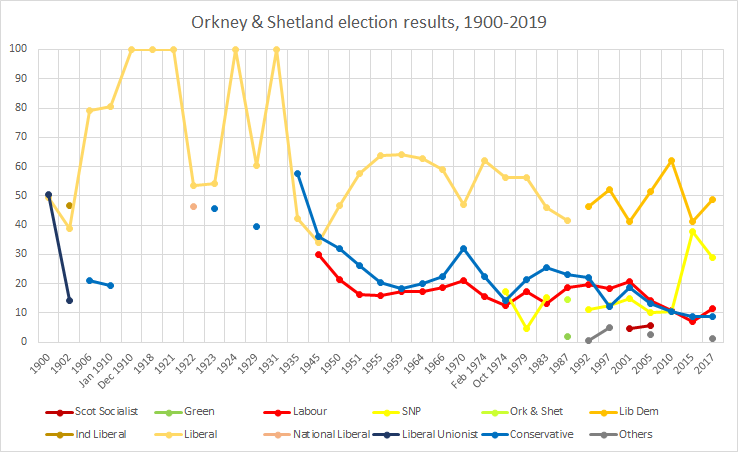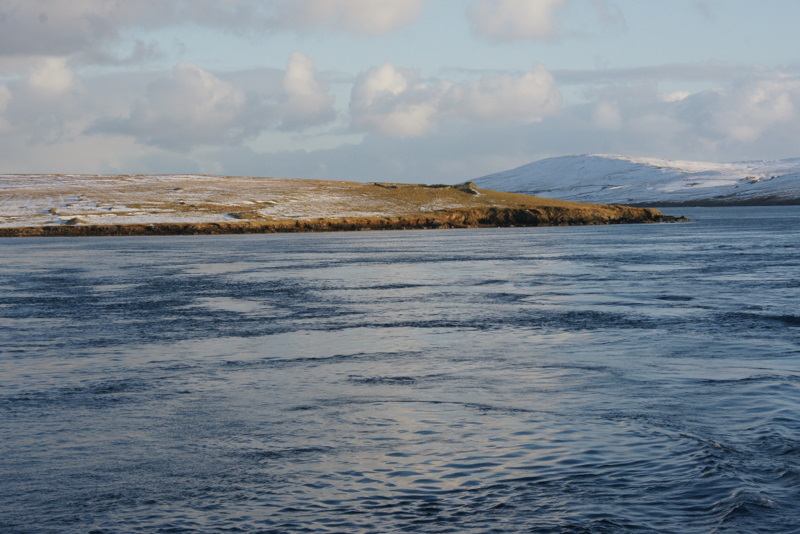|
Mossbank, Shetland
Mossbank is a village in the north east of the Mainland of Shetland, Scotland. Originally served by an inter island ferry steamer from Lerwick, this ceased when the Yell Sound ferry commenced from the small port of Toft, approximately 1 mile further north. The village was profoundly changed in the early 1980s when construction began on the nearby Sullom Voe oil terminal. Large amounts of temporary accommodation were erected to house the construction workforce, with the population expanding from 130 in the early 1970s to about a thousand a decade later. The number of residents staying in Mossbank is forever changing, making it hard to record a village population. The village has one primary school, Mossbank Primary School, a public house, The Welcome Inn, a shop, a Post Office & a local hall, from where the Youth Club is run. Mossbank and its adjoining area of Firth are in the parish of Delting Delting is a civil parish and community council area on Mainland, Shetland, Scotla ... [...More Info...] [...Related Items...] OR: [Wikipedia] [Google] [Baidu] |
Orkney And Shetland (UK Parliament Constituency)
Orkney and Shetland is a constituency of the House of Commons of the Parliament of the United Kingdom. It elects one Member of Parliament (MP) by the first past the post system of election. In the Scottish Parliament, Orkney and Shetland are separate constituencies. The constituency was historically known as Orkney and Zetland (an alternative name for Shetland). In the 2014 Scottish independence referendum, 65.4% of the constituency's electors voted for Scotland to stay part of the United Kingdom. Creation The British parliamentary constituency was created in 1708 following the Acts of Union, 1707 and replaced the former Parliament of Scotland shire constituency of Orkney & Zetland. Boundaries The constituency is made up of the two northernmost island groups of Scotland, Orkney and Shetland. A constituency of this name has existed continuously since 1708. However, before 1918 the town of Kirkwall (the capital of Orkney) formed part of the Northern Burghs constituency. It ... [...More Info...] [...Related Items...] OR: [Wikipedia] [Google] [Baidu] |
Delting
Delting is a civil parish and community council area on Mainland, Shetland, Scotland. It includes the Sullom Voe oil terminal and its main settlements are Brae, Mossbank and Voe. The parish, as described in 1882–1884, included the islands of Bigga (co-owned with the civil parish of Yell), Fishholm, Brother Isle, Little Roe, and Muckle Roe; of these only Muckle Roe was at that time inhabited. The landward area "varies in breadth from 3 to 6 miles, being much intersected by voes or arms of the sea". ''Quoting from Frances Groome's 1882-1884 Ordnance Gazetteer of Scotland Ordnance may refer to: Military and defense *Materiel in military logistics, including weapons, ammunition, vehicles, and maintenance tools and equipment. **The military branch responsible for supplying and developing these items, e.g., the Unite ...'' References External links * * Parishes of Shetland Mainland, Shetland {{Shetland-geo-stub ... [...More Info...] [...Related Items...] OR: [Wikipedia] [Google] [Baidu] |
Shetland
Shetland, also called the Shetland Islands and formerly Zetland, is a subarctic archipelago in Scotland lying between Orkney, the Faroe Islands and Norway. It is the northernmost region of the United Kingdom. The islands lie about to the northeast of Orkney, from mainland Scotland and west of Norway. They form part of the border between the Atlantic Ocean to the west and the North Sea to the east. Their total area is ,Shetland Islands Council (2012) p. 4 and the population totalled 22,920 in 2019. The islands comprise the Shetland constituency of the Scottish Parliament. The local authority, the Shetland Islands Council, is one of the 32 council areas of Scotland. The islands' administrative centre and only burgh is Lerwick, which has been the capital of Shetland since 1708, before which time the capital was Scalloway. The archipelago has an oceanic climate, complex geology, rugged coastline, and many low, rolling hills. The largest island, known as " the Mainland", ... [...More Info...] [...Related Items...] OR: [Wikipedia] [Google] [Baidu] |
Shetland (Scottish Parliament Constituency)
Shetland is a constituency of the Scottish Parliament ( Holyrood) covering the council area of Shetland. It elects one Member of the Scottish Parliament (MSP) by the first past the post method of election. It is also one of eight constituencies in the Highlands and Islands electoral region, which elects seven additional members, in addition to the eight constituency MSPs, to produce a form of proportional representation for the region as a whole. Shetland has been held by the Liberal Democrats at all elections since the formation of the Scottish Parliament in 1999, with the current MSP being Beatrice Wishart, who won the seat at a 2019 by-election held following the resignation of former party leader Tavish Scott. Electoral region Shetland is part of the Highlands and Islands electoral region; the other seven constituencies of are Argyll and Bute, Caithness, Sutherland and Ross, Inverness and Nairn, Moray, Na h-Eileanan an Iar, Orkney and Skye, Lochaber and Baden ... [...More Info...] [...Related Items...] OR: [Wikipedia] [Google] [Baidu] |
Shetland Mainland
The Mainland is the main island of Shetland, Scotland. The island contains Shetland's only burgh, Lerwick, and is the centre of Shetland's ferry and air connections. Geography It has an area of , making it the third-largest Scottish island and the fifth largest of the British Isles after Great Britain, Ireland, Lewis and Harris and Skye. Mainland is the second most populous of the Scottish islands (only surpassed by Lewis and Harris), and had 18,765 residents in 2011 compared to 17,550 in 2001. The mainland can be broadly divided into four sections: *The long southern peninsula, south of Lerwick, has a mixture of moorland and farmland and contains many important archaeological sites. ** Bigton, Cunningsburgh, Sandwick, Scalloway, and Sumburgh *The Central Mainland has more farmland and some woodland plantations. *The West Mainland ** Aith, Walls, and Sandness *The North Mainland – in particular the large Northmavine peninsula, connected to Mainland by a narrow isth ... [...More Info...] [...Related Items...] OR: [Wikipedia] [Google] [Baidu] |
Yell Sound
Yell Sound is the strait running between Yell and Mainland, Shetland, Scotland. It is the boundary between the Mainland and the North Isles and it contains many small islands. Sullom Voe, on the shores of which is a substantial oil terminal, is an arm of Yell Sound. The ferry to the North Isles crosses the sound, which can experience strong tides and adverse weather conditions. There are numerous shipwreck sites and several lighthouses to guide shipping. Yell Sound is mentioned briefly in the medieval ''Orkneyinga saga'' and during the 19th century there was a short flourishing of the kelp industry. Commercial fishing has long been a mainstay of the local economy and part of the sound is as Special Area of Conservation set up to protect the local wildlife. Early history The Old Norse name was ''Alasund'' although the original meaning of the name is not clear.Anderson, Joseph (Ed.) (1893) ''Orkneyinga Saga''. Translated by Jón A. Hjaltalin & Gilbert Goudie. Edinburgh. James Thin ... [...More Info...] [...Related Items...] OR: [Wikipedia] [Google] [Baidu] |
Toft, Shetland
Toft is a ferry port approximately one mile north of Mossbank on Mainland, Shetland, Scotland. From here, a car ferry service to Ulsta on the island of Yell operates. Toft is located in the parish of Delting. In the late 1970s and early 1980s there was a large workers camp situated here housing thousands of men who were building the Sullom Voe Terminal The Sullom Voe Terminal is an oil and gas terminal at Sullom Voe in the Shetland Islands of Scotland. It handles production from oilfields in the North Sea and East Shetland Basin and stores oil before it is transported by tanker. Constructi .... References External links Canmore - Toft, Norse Mill site record Vi ... [...More Info...] [...Related Items...] OR: [Wikipedia] [Google] [Baidu] |
Sullom Voe
Sullom Voe is an inlet of the North Sea between the parishes of Delting and Northmavine in Shetland, Scotland. It is a location of the Sullom Voe oil terminal and Shetland Gas Plant. The word Voe is from the Old Norse ' and denotes a small bay or narrow creek. The head of the voe makes up the eastern side of Mavis Grind. The Voe, the longest in Shetland, and partially sheltered by the island of Yell was used as a military airfield during World War II both by the Royal Air Force and the Royal Norwegian Air Force as a location for flying boats. With the coming of the oil terminal, the remains of the airfield were upgraded and modernised to create Scatsta Airport which was primarily used to service the terminal. The first crude oil was discovered in the North Sea in 1969, and soon thereafter construction began on the oil terminal at Sullom Voe, north east of the village of Brae, which became operational in 1975 and was completed in 1982, becoming the largest in Europe. Oil f ... [...More Info...] [...Related Items...] OR: [Wikipedia] [Google] [Baidu] |
The Welcome Inn
''The'' () is a grammatical article in English, denoting persons or things that are already or about to be mentioned, under discussion, implied or otherwise presumed familiar to listeners, readers, or speakers. It is the definite article in English. ''The'' is the most frequently used word in the English language; studies and analyses of texts have found it to account for seven percent of all printed English-language words. It is derived from gendered articles in Old English which combined in Middle English and now has a single form used with nouns of any gender. The word can be used with both singular and plural nouns, and with a noun that starts with any letter. This is different from many other languages, which have different forms of the definite article for different genders or numbers. Pronunciation In most dialects, "the" is pronounced as (with the voiced dental fricative followed by a schwa) when followed by a consonant sound, and as (homophone of the archaic pro ... [...More Info...] [...Related Items...] OR: [Wikipedia] [Google] [Baidu] |
Firth, Shetland
*''Note: "Firth" is a common name for sounds in Shetland'' Firth is a village in the north east of Mainland, Shetland, Scotland, in the parish of Delting, not far from Mossbank. It is 27 miles from Lerwick Lerwick (; non, Leirvik; nrn, Larvik) is the main town and port of the Shetland archipelago, Scotland. Shetland's only burgh, Lerwick had a population of about 7,000 residents in 2010. Centred off the north coast of the Scottish mainland a .... History Along with a stone memorial at the entrance to the village, many abandoned croft houses still stand on the hill across Firth Voe from Mossbank. These commemorate the infamous " Delting Disaster" of 21 December 1900 when twenty-two local fishermen were lost during a storm, decimating the community. Because of the oil industry, which grew in 1970s Shetland, a number of temporary dwellings were built, followed by some housing estates, some now demolished. Footnotes External links Canmore - Elizabeth: Infield, Delting ... [...More Info...] [...Related Items...] OR: [Wikipedia] [Google] [Baidu] |




.png)